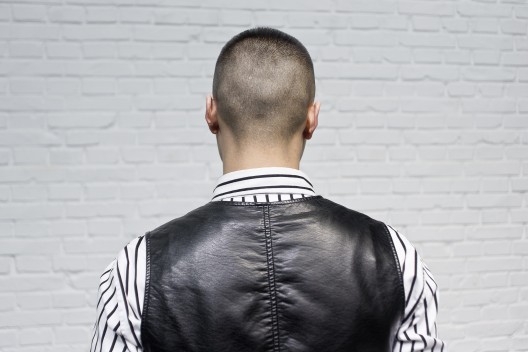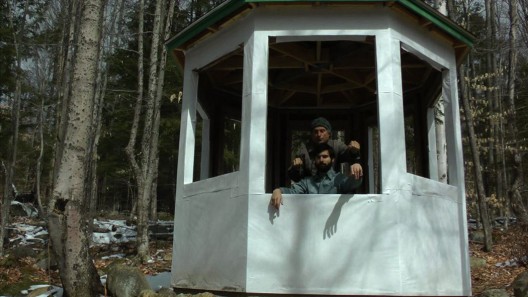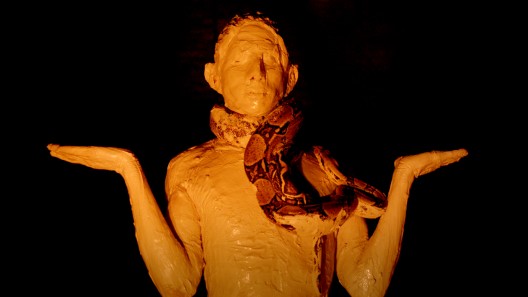inCube Arts (314 West 52nd Street, #1, New York, NY 10019, USA), May 7–28, 2016
It is not often that one witnesses male vulnerability in group exhibitions nowadays. “Son: Signal of Authority”, co-curated by Boliang Shen and Zhanglun Dai at the non-profit space inCube Arts in New York was an exception.
Consisting of four video pieces by male artists under 35 years old, the exhibition displayed depictions of father figures that are complicated, and which sometimes seem cruel and obscure. Yan Xing’s “DADDY Project” (2011) is an hour-long autobiographical performance describing the absence of a father in the artist’s childhood, and the ensuing confusions and struggles Yan faced. Chen Zhou films father and son in a clammy nightmarish fantasy with a hint of David Lynch, using words Chen’s father once told him when he was a kid as the work’s title: “Wake Up, My Son, You’re Still in a Dream” (2011) to further blur the boundary between reality and dream.
We see Yan’s back and shoulders twitching as he narrates dramatic family stories, while in Chen’s video, the son is portrayed as a weak boy with dry lips and empty eyes. These vulnerabilities are peculiarly obvious in being someone’s son; but rather than referencing a form of Oedipal complex, the curators see the modern “son” as “a sort of symptom of contemporary culture that needs to be interrogated.” An irresponsible father has had a traumatic influence on Yan. Yet the artist says at the beginning of the piece that he had invited his father to this performance; he then directs questions and accusations, but also dedications to his invisible father publicly. Their relationship comes across as a blurred and intense one, as well as a fluid and twisted version of the “friend-enemy distinction” as defined in a political context by Carl Schmitt.[1]


A political element was indeed among the curators’ intentions. In place of a curatorial statement, they present a poem from Shakespeare’s The Tempest (both for the wall text and audibly as a backdrop to the show) accompanied by a front page of New York Times published about ten days after 9/11. The latter tells the story of hijacker Mohammed Atta’s father denying that his “cream puff” son could have the guts to commit such an act —quotations that were referenced by Prof. Avital Ronell in her book Loser Sons: Politics and Authority. Ronells describes sons “who grow up unhappily believing that no matter what they do, they cannot please their fathers,” would “take up the slack to respond to an unmarked strain in existence”, and/or make serious problems for others; she claims George W. Bush and Osama bin Laden also fall into this category.[2]
“Loser sons” might be one of the most miserable and violent instances of the stereotype. The artist Rafael Kelman includes in his work “Untitled (Events That Were Never) from Gigantomachy” (2013), two similar stories relating to terrorists but in a much more twisted context: two “fake” bombers who fell into traps laid by the authorities through agent provocateurs. One happened in 2009 to a 19-year-old Jordanian, and the other in 1936 to a 21-year-old German Jew who was in fact the artist’s great uncle. Kelman also invites his mime actor father to shave for him, put white paint on his face, and teach him mask-acting and puppet shows. These actions hint at the fake bombers’ tragedy of being manipulated, while also presenting a casual intimacy between the artist and his father by way of balance.

Ben Hagari’s “Potter’s Will” (2015) is a piece not literally about biological fathers, but related to the concept of creators in a broader way. Hagari inverts the gravity of a potter’s workshop: the whole room is spinning while the pottery-making wheel looks immobile, as if the creator is being shaped by his creation, not vice versa. Hagari then covers his body in thick clay from head-to-toe, risking being fired himself. A snake wraps around his neck; the moment it drops to the floor and turns into a crutch, Hagari advances his theme towards the idea of a father/creator with religious significance. It should be noted that the artist comes from Tel Aviv, where the snake and crutch are symbolically related to Moses in the Book of Exodus.
How to deal with legitimate authority is the exhibition’s hidden question. Rather than adopting attitudes which challenge, oppose, or even subvert what is proposed by most radical activists in circumstances of sovereignty, these artists’ works offer alternative perspectives through a familial lens: from the depiction of an absent father to the revisiting of nightmare-like scenes, an analysis of the artist’s great uncle as a fake bomber and learning from a mime actor father, and the reversal of the creator-creation relationship. The curators are a married couple in real life; marriage, potentially the most compact model of communism, corresponds to paternity which entails the possibility of being the smallest model of centralism.

“All destination,” said anthropology professor James Boon, and “no filiation.”[3] Such a statement is apt to describe the present moment of many of us: going out from our families and gathering in modern metropolises as individuals. The freedom and autonomy that result from leaving the family unit push us to strive in highly competitive cities; at the same time, this indirectly generates instability and a fluidity of social power with an unspoken threat. Paolo Virno said “I need to be granted a certain degree of autonomy in order to be exploited.”[4] If we see the possibilities in ourselves being typical Post-Fordist workers, whose “entire lives become job competency and thus devoted to the labor process”, then perhaps the family could be a battlefield to at least question such a cruel fate. With this in mind, the confrontation with and rethinking of familial social power proposed by this exhibition is certainly worth considering.
[1] Carl Schmitt states in his The Concept of the Political (The University of Chicago Press, expanded edition, 2007) that “the specific political distinction to which political actions and motives can be reduced is that between friend and enemy” (p. 26); he places a lot of emphasis on this “ever present possibility of conflict” (p.32). Furthermore, in both cases, the artist’s focus on childhood might loosely reflect the concept of neoteny (“the permanence of infantile characteristics in adult subjects”). This “calls upon by the modern theory of state sovereignty”, in Paolo Virno’s reference to both Hobbes and Schmitt. It might be a digression to use Virno’s words here (from Paolo Virno, Anthropology and the Theory of Institutions, (http://eipcp.net/transversal/0407/virno/en, 2007), since his main concern in the article is not about neoteny. However, it is noteworthy that Virno thinks that “language performs its protective and stabilizing role vis-à-vis the language faculty, which is to say neoteny”, that language “compensates for individual infancy, that is for that condition in which one does not speak though one possess the capacity to do so”. Virno considers language to be the pure and foremost institution that “makes possible all the other institutions” (non-political and political ones); thus, neoteny has its particular significance in his re-reading of Schmitt and related political theories. The effects of childhood experience that are manifest in adult life could be a psychological neoteny. The father-son relationship could thus be considered as a prototype of sovereignty; it is also the smallest unit of political relations and social hierarchical interaction.
[2] Avital Ronell, Loser Sons: Politics and Authority, (University of Illinois Press, 2013).
[3] James A. Boon, Affinities and Extremes, (University of Chicago Press, 1990).
[4] “The Dismeasure of Art. An Interview with Paolo Virno”, in the magazine Open 17 “A Precarious Existence. Vulnerability in the Public Domain”, 2009.


